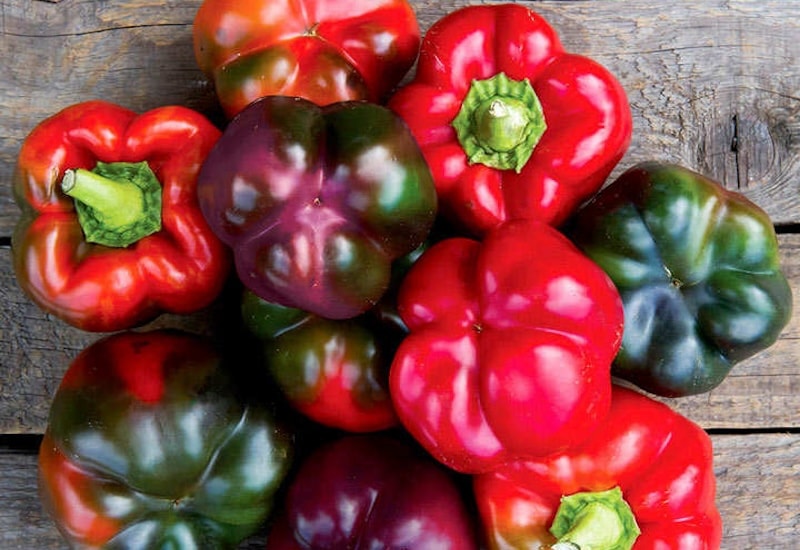Sweet peppers are relatively easy to grow from seed and you don’t necessarily need a greenhouse to produce a successful crop. In fact you can grow them in a container on a sunny patio or in a warm conservatory. We asked experienced allotment grower Lee Senior for his advice on growing sweet peppers at home. Here are his top tips.
Browse our full range of sweet pepper seeds for inspiration.
How to choose the best sweet pepper variety to grow
Whether you have a small veg patch, a couple of patio containers, or an allotment like me, there are lots of sweet pepper varieties from which to choose. Here are a few of my favourites:
- Sweet Pepper ‘Sweetonia Mix’: For smaller, mini-peppers this is the one to go for! An early spring sowing will yield a good crop with a deliciously, crunchy, lightly spicy sweet pepper taste. I’ve found that ‘Sweetonia’ is also ideal as it can be consumed in one meal while it is still at its freshest.
- Sweet Pepper ‘Thor’ F1: This is a large-sized, deliciously crisp and sweet tasting long-shaped variety which develops into an attractive vibrant glossy red colour. As an added bonus, it comes as a grafted plug plant which will ensure a larger, more disease resistant plant.
- Sweet Pepper ‘Californian Wonder’: This is a reliable, long-standing variety which has green fruits that gradually mature to red. It is the first sweet pepper that I ever grew and it remains popular in the UK today.
- Sweet Pepper ‘Blockie Mix’ F1: This produces a mix of orange, red and yellow peppers of a slightly ‘blocky’ shape. The flavour is mild and sweet. This is quite an early variety if grown in good conditions and is ideal for sowing during late winter.
How to sow sweet pepper seeds
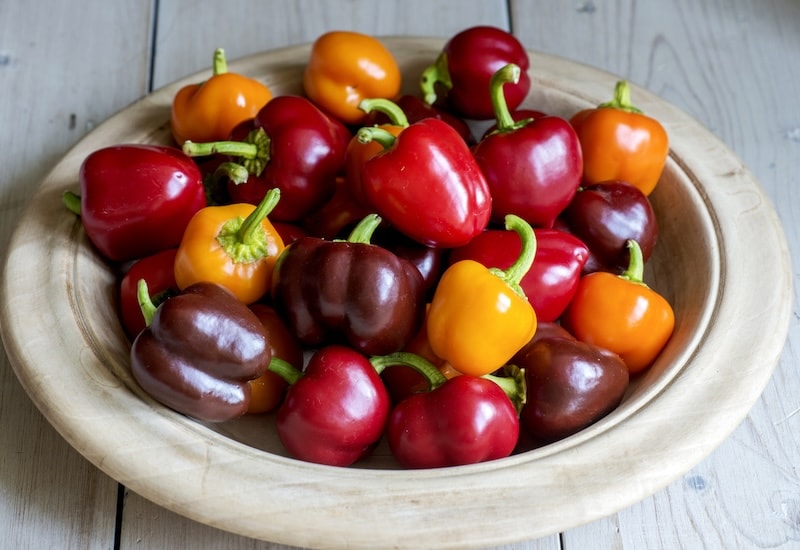
Image: Sweet Pepper ‘Sweetonia Mix’ from Suttons
Sweet peppers require a long growing season. The seed can be sown in late winter or early spring, up to early April.
Sweet peppers are one of the first sowings I make in the New Year, as long as I can guarantee enough warmth for germination. This can be done using a heated propagator or a warm windowsill near a radiator.
- Prepare a tray of good quality compost.
- Sprinkle a few seeds on top, and lightly cover them with 6mm of sieved or fine compost.
- Germination takes between 10-21 days at a temperature of not less than 18C.
- Grow your seedlings on during early-to-mid spring in temperatures of 16C-20C and ensure that night time temperatures don’t drop below 14C.
- Take care not to overwater the compost before germination and also at the seedling stage.
How to plant sweet peppers
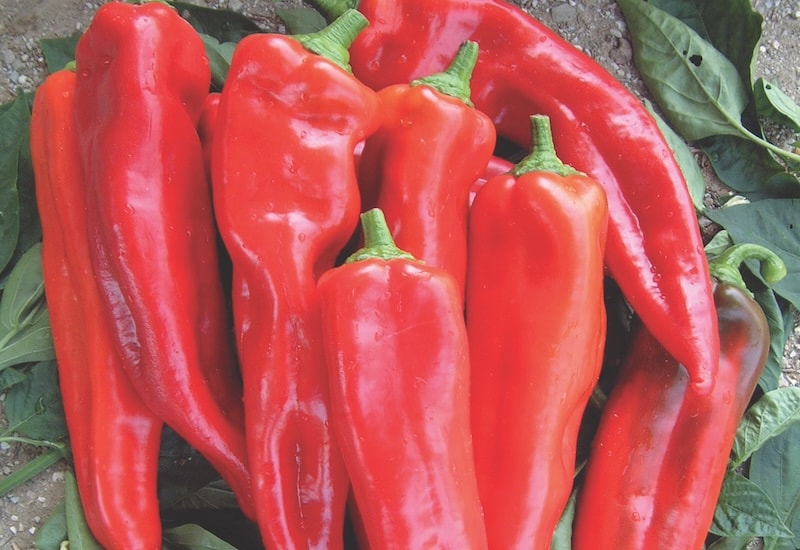
Image: Sweet Pepper ‘Thor’ F1 potted plants from Suttons
Gently pot the seedlings on when they have at least two seed leaves, and then again to incrementally larger pots as the plant develops. The final pots should have a diameter of at least 12 inches (30 cms), but if possible, choose containers slightly larger than that.
Sweet peppers can also be planted directly into grow bags, but this option does require very careful and more frequent watering.
Ideally, your compost mix should be free-draining. Good quality home-made garden compost mixed with proprietary compost works very well, with added perlite if necessary.
Where to grow your sweet peppers
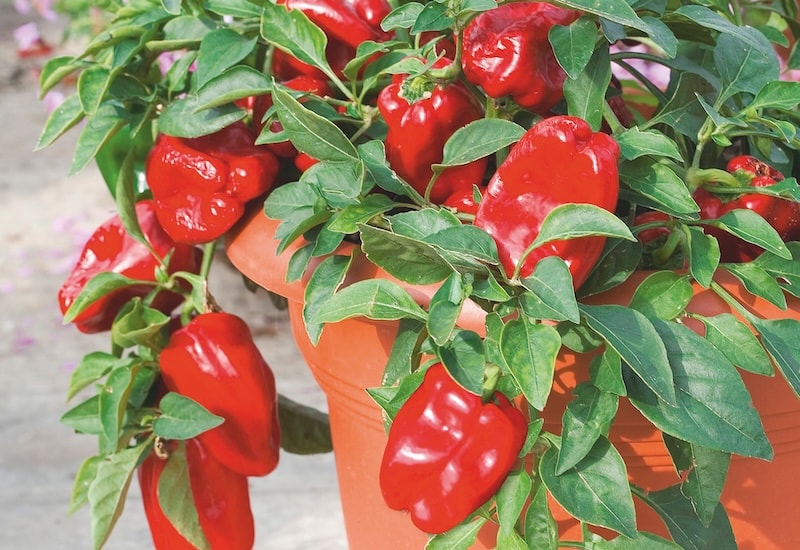
Image: Sweet Pepper ‘Redskin’ from Suttons
Sweet peppers need a warm and sunny location to thrive. They dislike cold conditions and are usually grown in the greenhouse or polytunnel in the UK. Attractive plants that reach a height of about 60cm tall, they can also be grown in a sunny conservatory.
If you live in a milder part of the UK and have a sheltered, sunny courtyard, balcony or patio, your sweet peppers could be grown outside in containers. If you’re growing your sweet peppers outdoors, choose a variety with smaller fruits that will ripen quicker than their larger counterparts. However, for many of us the most realistic option is to grow the plants under cover.
How to care for sweet peppers
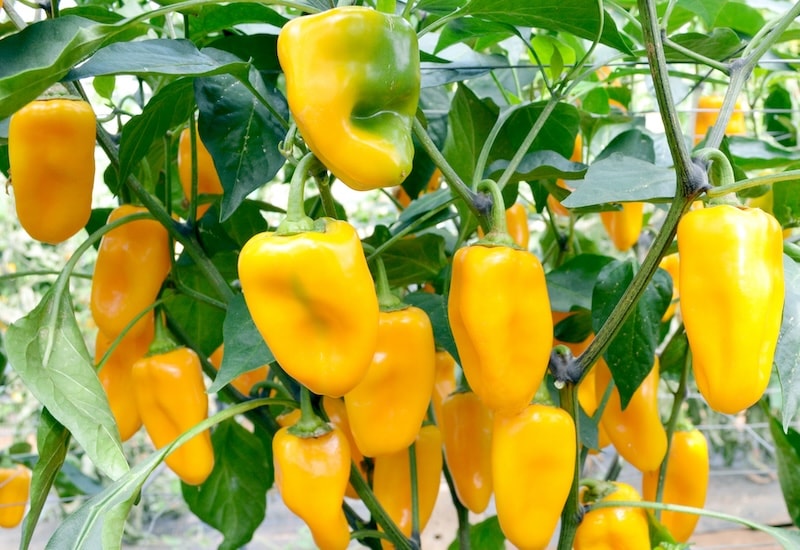
Image: Sweet Pepper ‘Midas’ from Suttons
It’s fair to say that while sweet peppers aren’t difficult to grow, they are a little more fussy than tomatoes. Slower growing, they need a longer season to produce a ripe crop.
Getting the temperature just right can be tricky too. Although sweet peppers insist on warmth, they don’t like it too hot either! Problems can arise when temperatures consistently go above 30C (86F), especially if the air is too dry. Try to create a moderately humid environment in your greenhouse or polytunnel, similar to that for cucumbers.
I tend to pinch out the top of my young plants to encourage side shoots to form. This will ultimately result in a heavier, better balanced crop. If your plant has a set a heavy crop or has grown a little bit too leggy, staking it for extra support is a good idea. And once the flowers appear, apply a high potassium fertiliser such as tomato food, once a week.
Harvest the peppers when they are at the colour you prefer depending on the variety chosen. Many will go from green to red, but some varieties can be yellow or orange. It’s worth noting that red peppers are a lot sweeter than green ones.
Common problems with sweet peppers
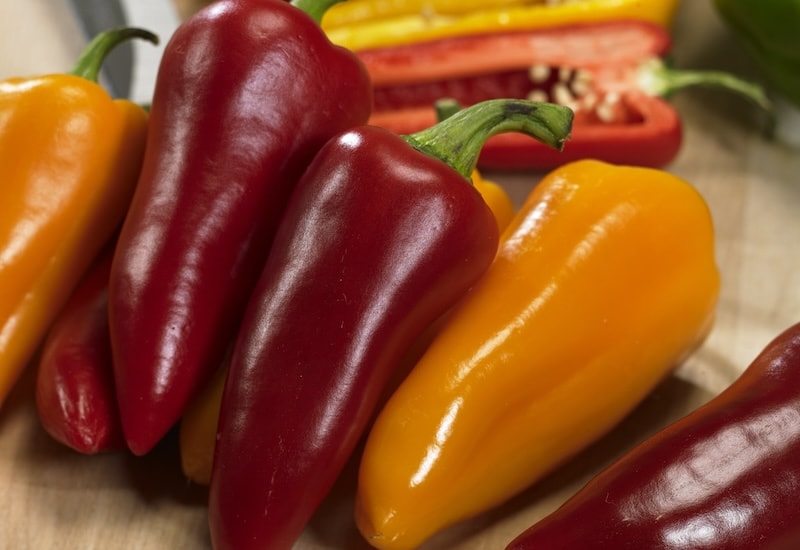
Image: Sweet Pepper ‘Pillar Sweet Trio’ seeds from Suttons (©Prudac / Visions BV, Netherlands)
- One of the most common problems with sweet peppers is the flowers dropping off, rather than setting. This is usually due to erratic watering, in particular a shortage of water, which causes dryness at the roots. An automated watering system can help with this.
- Another potential problem is blossom end rot on the fruits. This is also due to inconsistent watering (in the same way as tomatoes).
- Aphid attacks can be an issue, especially on plants that are under stress for any reason. Strong and healthy plants are far less susceptible to attack.
- Botrytis (grey mould) can also strike if the plants are too crowded or growing conditions are too much on the humid side. Space your plants well apart and ensure there is good airflow around your greenhouse or polytunnel.
We hope we’ve inspired you to grow your own sweet peppers, even if you don’t have a greenhouse. Find more of Lee’s practical, hands-on, vegetable growing advice over at his monthly allotment pages.
Lead Image: Pepper F1 ‘Cardinal (Purple)’ from Suttons
Last Updated on December 11, 2024 by Suttons Horticultural Team

